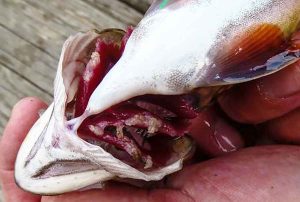
Brook trout are susceptible to gill lice infestations.
Photo: Wiki Commons
Chronic wasting disease. West Nile virus. The hemlock woody adelgid. The spotted lanternfly. Mange.
The list of invasive creatures and diseases playing havoc with Pennsylvania fish and wildlife seemingly goes on and on.
And now there’s this.
Gill lice, parasitic crustaceans that attach to the gills of trout, are turning up in more and more wild trout waters across Pennsylvania.
That might turn out to be mere annoyance. It might be a real problem.
No one knows yet, it seems.
“It could be that we go to a stream, we handle 100 fish, and 10 of them have gill lice, but none of them have more than three gill lice each. And that may not lead to any mortality greater than the next flood or the next drought,” for example, said Andy Shiels, director of the Pennsylvania Fish and Boat Commission’s fisheries bureau. “But we could go to another stream, where we handle 100 fish, and 70 of the fish have gill lice, and they all have five or 10, which could cut the population in half or by 70 percent.
“That’s what we’re trying to ascertain, is just what degree of infestation is a problem at a population level.”
It’s a new problem.

Gill lice on a brook trout.
Photo: Wisconsin Trout Unlimited
Gill lice first showed up in Pennsylvania in 2016 during a routine survey of Wolf Run in Centre County.
The lice were abundant, too. Shiels said they were so plentiful as to be a “show stopper.”
The same sportsmen’s club that stocked that stream put fish in nine others. Commission biologists surveyed them, too.
All contained trout with gill lice.
The club depopulated its nursery, meaning it killed all it remaining fish. And biologists hoped that would end the problem.
The 10 streams flow into another, larger one impacted by acid mine drainage, said Dave Nihart, the commission’s coldwater unit leader. Fish likely can’t swim beyond that pollution, he noted.
But the gill lice problem is turning out to be bigger than expected.
The lice that attach to brook trout are showing up in many parts of the state. The lice that attach to rainbows – they are a species specific parasite – are occurring in the southeast region of the state.
They’re persistent and potentially damaging, too.
For example, in 2017 biologists re-surveyed five of the 10 Centre County streams containing lice the year before.
“We found gill lice in four of the five streams,” Nihart said.
And the only one that no longer had gill lice also no longer had wild brook trout, he added.
Likewise, biologists sampled another stream in the northern tier with gill lice. They collected 150 brook trout in a 500 meter section of it in 2016. In 2017, after lice showed up, they found four brookies in about the same amount of water, two of which had gill lice.
So the question, Nihart said, is are limiting brook trout populations themselves, or are they simply another stressor that makes fish more vulnerable in the face of things like flood and drought and other issues?
Other states are dealing with this issue, namely West Virginia and Wisconsin. That letter state is doing a lot of research on the issue.
Kris Kuhn, chief of the commission’s division of fisheries management, said Pennsylvania officials are studying that research for answers. So far, it seems young of the year brook trout seem most susceptible to perishing.
If they die, he said, and there are any wild brown trout around, the latter move in and the brookies disappear.
“And so that’s our concern,” Kuhn said.
It’s a big one, said Ed Mascharka, a commission board member from Erie County. He called the presence of lice “dangerous” for Pennsylvania fisheries.
“We have a growing abundance of clean water in Pennsylvania that we’ve never had in our lifetimes,” he said. “We have a growing population of fish in Class A streams in fishable locations and destinations. And this gill lice thing is throwing a huge curveball right at that.
“So going forward, what are we going to do about where it’s at?
The answer is several things, Shiels said.
First and foremost, the commission is trying to “turn off the spigot” that’s sending lice into streams.
All of the streams where lice occur have one thing in common, he noted. Namely, they stocked trout purchased from commercial hatcheries.
“There really is a common denominator,” Shiels said.
But the commission isn’t identifying those hatcheries for several reasons, he said. It’s never examined any of them and doesn’t have the authority to. It’s possible a hatchery that had gill lice could have since gotten rid of them, too, he added.
But, going forward, cooperative nurseries and sportsmen’s clubs that buy trout for stocking must purchase fish only from a certified, gill lice-free facility.
“That’s how we make sure at the end that we can control that new fish will gill lice aren’t getting into the environment,” Shiels said.
The commission is also significantly ramping up surveillance. Staff all across the agency – from biologists to hatchery personnel to law enforcement officers – are on the lookout for gill lice, Shiels said.
And that commitment continues and will until answers are found, he added.
“We’re serious about it and we’ll stay with it until we figure it out,” Shiels said.
Want to see more? Check us out on Facebook, Twitter and Instagram.









